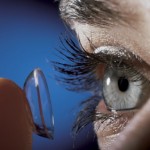Historically, the solution to impaired vision has been to don a pair of corrective lenses. The options are either to wear glasses or to wear contact lenses. Contact lenses are arguably more expensive but the freedom granted by them is well worth it to most people. The average set of spectacles costs anywhere from $100 to $500, and contacts will generally run toward $400-$500 per year to maintain. It might be surprising to you to know that contacts have been around since the late 1800’s, and flexible contacts were first patented and sold in countries in 1959.
If you are of the unfortunate like me, you probably can’t afford laser eye surgery so you are going to have to make a choice between contacts and glasses to gain acceptable vision. The decision is usually one of caution, people aren’t often willing to step outside the comfort zone and change from glasses to contacts, but is there any reason to be hesitant? Below I have compiled some information to help you make an educated decision as to what is best for you.
How Corrective Lenses work
Since you’ve just read my page on long and short sightedness, you will know that the cause for both vision problems is that the eye is either too long or short, or the lens is too flat or steep. The result is that the focal point of light entering the eyeball is either too far in front or too far behind the retina for the eye to automatically compensate. Corrective lenses work by modifying the path of the light as it approaches your eye such that between the artificial lens and the lens of your eye – the light focuses on the retina. Lenses placed close together have a relatively additive relationship making it very easy for an optometrist to test and prescribe you accurately with suitable lenses.
To briefly explain the additive nature, you must understand that the optical power of any lens is measured in ‘diopters’. For example, a 3 diopter lens brings parallel rays of light to focus at 1/3 metre. The additive nature of lenses assembled near to each other means that if your eye is -1 diopters out of focus (short sighted), a 1 diopter power Corrective lens fitted to your glasses, or worn as contacts will cause the light to focus correctly on to your retina.
Can you cure color blindness with glasses?
To read more you can visit my page covering this topic here. In short, yes there are a number of companies that specialise in improving color recognition for color blind people through special lenses.
Why Buy Glasses

Glasses are a simple, convenient way to correct your vision. There are a huge range of styles available today making it possible to choose glasses that complement and accentuate your features. You can take them off anytime, and put them on whenever you want – no sterilisation required unlike contact lenses.
You pay an upfront price that you can plan ahead for. If you are under 20, between a probable active lifestyle and a progressing prescription, you can expect to need glasses as often as every 12 months. Around the age of 20, most of you can expect your prescriptions to stabilise; from this point on most people tend to average a new pair every 2 years.
In recent years the price of glasses has crashed, you can get frames & lenses for as little as $100 AU, or over $500 AU and beyond for designer frames, and special lenses.
Why Buy Contacts

Many people see contacts as a way to regain some of the freedom lost to needing to wear glasses. While for many people glasses are comfortable, they aren’t for all. Contacts take away the need to wrap frames around your face; you can also get water splashed in your face and not have to go looking for a nice piece of cloth before you can see again.
Contacts also offer further vision improvements, being closer to the eye they offer more natural vision, and your entire field of view is in focus – unlike glasses where you have to contend with being able to see the edges of the frames, and of course having blurred vision outside the frames.
There are also some health benefits, for example the ability to wear higher quality sunglasses is important for eyes, as UV damage to eyes is known to lead to a number of vision degrading diseases.
There are numerous other differences that may be considered benefits to particular people such as being active playing sport etc, getting caught out in the rain, and an unmodified personal appearance.
Wearing contacts does come with 3 main trade-offs. You can’t just take them on and off when you please, you need to sterilise and brave the insertion/removal process each time, morning and night regardless. The cost will also tend to average higher per year than glasses. Thirdly and most importantly, some eyes simply can’t handle contacts; they react to them and making wearing contacts too uncomfortable.
For many years now the cost of wearing contacts year round has hovered around $400 AU or more per year. A year’s supply of lenses usually fetches somewhere around $200-$300 for basic lenses, with the remainder being comprised mainly of the fluids to sterilize the lenses etc.
Summary: Glasses Vs Contacts
Glasses:
Pros –
- Convenient, easy to put on and take off
- Cheap, plan-able expense
- Many flattering choices available
Cons –
- Limiting when playing sports etc
- Frustrating when caught in the rain, etc
- Lower level of access to UV protective eye-ware
- Poor Peripheral vision
- Fogginess during temperature change
Contacts:
Pros –
- Allows flexibility when it comes to physical activity
- More natural vision
- Full field of vision
- No change to natural appearance
- More comfortable for most
Cons –
- More work involved maintaining lenses
- Some people are unable to use them without pain
- Higher average cost, at $400 a year, within as little as 10 years, the cost will have outweighed laser eye surgery
- If one falls out during the day, you have little chance of finding it compared to if your glasses fell off
Owing to the fact that both forms of eye-ware have decreased in cost while standard incomes have risen, most people are able to afford both glasses and contacts. This is the ideal situation for most people that want the flexibility granted by contacts, but the simplicity and convenience of wearing glasses during other times.
On a personal note, I dearly wish I could afford laser surgery yet I have never worn contacts as I’m not prepared to own contacts without a backup pair of glasses (I have a tradition of destroying my frames during sport). Even writing this page for you, I realised how much I’m ready for freedom from my frames – I’ll be off to get contacts ASAP… Before I destroy my current frames! Laser surgery one day … 🙂
da best. Keep it going! Thank you